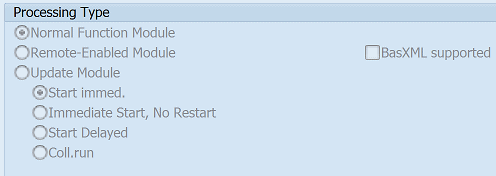SAP HRPY_CD_READ_LAST_KR Function Module for
HRPY_CD_READ_LAST_KR is a standard hrpy cd read last kr SAP function module available within SAP R/3 or S/4 Hana systems, depending on your version and release level. It is used to perform a specific ABAP function and below is the pattern details, showing its interface including any import and export parameters, exceptions etc. there is also a full "cut and paste" ABAP pattern code example, along with implementation ABAP coding, documentation and contribution comments specific to this or related objects.
See here to view full function module documentation and code listing for hrpy cd read last kr FM, simply by entering the name HRPY_CD_READ_LAST_KR into the relevant SAP transaction such as SE37 or SE38.
Function Group: HRPAYKR01
Program Name: SAPLHRPAYKR01
Main Program:
Appliation area: P
Release date: N/A
Mode(Normal, Remote etc): Normal Function Module
Update:

Function HRPY_CD_READ_LAST_KR pattern details
In-order to call this FM within your sap programs, simply using the below ABAP pattern details to trigger the function call...or see the full ABAP code listing at the end of this article. You can simply cut and paste this code into your ABAP progrom as it is, including variable declarations.CALL FUNCTION 'HRPY_CD_READ_LAST_KR'".
EXPORTING
YEAR = "Serach year
IMPORTING
OUT_SEQNR = "Output of payroll record
TABLES
RGDIR = "Payroll results
EXCEPTIONS
NO_RECORD_FOUND = 1 NO_ENTRY_T549A = 2 NO_ENTRY_T54C1 = 3
IMPORTING Parameters details for HRPY_CD_READ_LAST_KR
YEAR - Serach year
Data type: T54C1-PABRJOptional: No
Call by Reference: No ( called with pass by value option)
EXPORTING Parameters details for HRPY_CD_READ_LAST_KR
OUT_SEQNR - Output of payroll record
Data type: PC261-SEQNROptional: No
Call by Reference: No ( called with pass by value option)
TABLES Parameters details for HRPY_CD_READ_LAST_KR
RGDIR - Payroll results
Data type: PC261Optional: No
Call by Reference: No ( called with pass by value option)
EXCEPTIONS details
NO_RECORD_FOUND - No record found
Data type:Optional: No
Call by Reference: No ( called with pass by value option)
NO_ENTRY_T549A -
Data type:Optional: No
Call by Reference: No ( called with pass by value option)
NO_ENTRY_T54C1 -
Data type:Optional: No
Call by Reference: No ( called with pass by value option)
Copy and paste ABAP code example for HRPY_CD_READ_LAST_KR Function Module
The ABAP code below is a full code listing to execute function module POPUP_TO_CONFIRM including all data declarations. The code uses the original data declarations rather than the latest in-line data DECLARATION SYNTAX but I have included an ABAP code snippet at the end to show how declarations would look using the newer method of declaring data variables on the fly. This will allow you to compare and fully understand the new inline method. Please note some of the newer syntax such as the @DATA is not available until a later 4.70 service pack (SP8), which i why i have stuck to the origianl for this example.| DATA: | ||||
| lv_year | TYPE T54C1-PABRJ, " | |||
| lt_rgdir | TYPE STANDARD TABLE OF PC261, " | |||
| lv_out_seqnr | TYPE PC261-SEQNR, " | |||
| lv_no_record_found | TYPE PC261, " | |||
| lv_no_entry_t549a | TYPE PC261, " | |||
| lv_no_entry_t54c1 | TYPE PC261. " |
| CALL FUNCTION 'HRPY_CD_READ_LAST_KR' " |
| EXPORTING | ||
| YEAR | = lv_year | |
| IMPORTING | ||
| OUT_SEQNR | = lv_out_seqnr | |
| TABLES | ||
| RGDIR | = lt_rgdir | |
| EXCEPTIONS | ||
| NO_RECORD_FOUND = 1 | ||
| NO_ENTRY_T549A = 2 | ||
| NO_ENTRY_T54C1 = 3 | ||
| . " HRPY_CD_READ_LAST_KR | ||
ABAP code using 7.40 inline data declarations to call FM HRPY_CD_READ_LAST_KR
The below ABAP code uses the newer in-line data declarations. This allows you to see the coding differences/benefits of the later inline syntax. Please note some of the newer syntax below, such as the @DATA is not available until 4.70 EHP 8.| "SELECT single PABRJ FROM T54C1 INTO @DATA(ld_year). | ||||
| "SELECT single SEQNR FROM PC261 INTO @DATA(ld_out_seqnr). | ||||
Search for further information about these or an SAP related objects